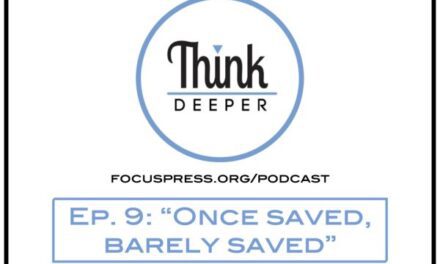By Jack Wilkie
In last month’s “Digging Deeper,” we looked at Peter’s first epistle. Written in approximately 64 A.D., it focused on the persecutions that the Christians of the first century were facing. In his second letter, Peter focused on the other major problem that the early church was facing. As we can see from 1 John (a letter written about thirty years later), the earliest forms of Gnosticism were gaining ground in response to the spread of Christianity. Other false teaching existed at the time as well, but one major teaching that was addressed numerous times in the New Testament was the misunderstanding of Jesus’ return and the afterlife. So, Peter decided to write these Christians to remind them that they already knew the truth and that they should use it to stand firm against the false prophets in the world.
Background Information
Of all of the twenty-seven New Testament books, none has had its authorship questioned as much as 2 Peter. The two main charges against his authorship were that it wasn’t confirmed and directly quoted by the early church as many of the other books, and that the style and content matched Jude more than 1 Peter. However, there are numerous reasons to assume that the letter is authentic. One commentator addressed the issue early church quotation by saying that “there are possible or probable traces of 2 Peter in 1 Clement (95 A.D.), 2 Clement (150 A.D.), Aristides (130 A.D.), Hermas (120 A.D.), Valentinus (130 A.D.), and Hippolytus (180 A.D.).”i Stylistically, the letter isn’t an exact replica of 1 Peter, but similarities exist and 2 Peter is far more credible than every other pseudepigraphical writing attributed to Peter.
As for the date, history tells us that Peter wrote his first letter in 63-65 A.D. and that he was killed before 68 A.D., so this second letter would have to date back to either 65, 66, or 67 A.D. While he doesn’t open the letter by addressing his audience in the same way as he did in 1 Peter 1:1, many point to the statement in 3:1 where Peter mentions that this is the second letter he is writing to the intended audience as proof that he was writing to the same group of readers.
Key Themes
Any time a writer gives a purpose statement as Peter did in 3:1-2, we should take note of it and see the rest of the letter with that point in mind. “Beloved, I now write to you this second epistle (in both of which I stir up your pure minds by way of reminder), that you may be mindful of the words which were spoken before by the holy prophets, and of the commandment of us, the apostles of the Lord and Savior.” So, Peter wanted his readers to be mindful of the things they had heard. Why? So they would be knowledgeable about the Truth and confident that they could rely on the Scriptures and commandments they had received. Why did they need to have that knowledge and confidence? So they could stand strong against false teaching.
Key Verses
Of course, 3:1-2 is the most important section for understanding the book. Another purpose statement of sorts can be found in 1:12-15. In this section Peter noted that his goal was that he could remind them of the Truth so well while he remained on earth that they would continue to use those teachings after he was gone.
Some of the verses in the book cover both of the major themes. Consider 1:19-21, where Peter ensured that the Scriptures could be trusted, that they should be given attention, and that they will not be changed based on what men say. Another is 3:17-18, where two commands are given––be on your guard against unprincipled men and grow in the grace and knowledge of Christ.
Key Words
Because of the focus on false teachers and the need to be prepared to refute them, knowledge dominates the text of 2 Peter as a keyword. It appears in some form (know, known, knowing, or knowledge) seventeen times, or sixteen depending on your translation. Along with knowledge, the word remind is an important one as Peter repeatedly states his goal of reminding them of what they know. Finally, diligent/diligence occurs four times, showing the urgency and necessity of the work set before us.
In an age that is rife with religious teachings of every sort and thousands of different belief sets, we need a constant reminder to be diligent to grow in knowledge of the Word and stand firm in it. With these principles of 2 Peter in mind, I hope you’ll take some time to go verse by verse in this book and work to grow your knowledge by digging deep.


